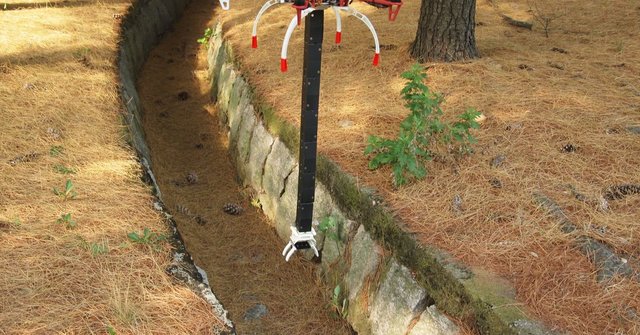This drone has an origami arm that unfolds to pick up objects
In a quest to make drones more functional (and just a little bit creepier), scientists have created a foldable robotic arm that allows drones to pick up objects inside narrow ditches.
The arm, described in a study published today in Science Robotics, is made of seven plastic actuators that look like rectangular boxes stacked up on top of each other and stretching up to 27.5 inches (70 centimeters) in length. But what’s special about the actuators is that they can be folded flat, so that the arm is stowed away. Scientists attached the arm to a drone. When equipped with finger-like grippers, the arm could grab an object at the bottom of a ditch. When equipped with a camera, it could take video among tree branches.
“Folding, packaging of everyday things are everywhere,” study co-author Kyu Jin Cho, director of the Soft Robotics Research Center at Seoul National University, tells The Verge in an email. “Why not for robots?”
Foldable robots are becoming more and more popular. Called “origami robots,” they’re made of flat sheets of metal or plastic that fold and unfold so that the bots can move. Researchers at MIT have even created a swallowable origami robot made of meat and origami exoskeletons that allow tiny bots to be more versatile. At Harvard University, engineers turned to kirigami — the Japanese art of paper cutting, rather than folding — to create artificial snakeskin that enables a soft robot to crawl forward.
The foldable actuators in the robotic arm fold and unfold in an ingenious way. Elastic bands inside the actuators pop them open into stiff rectangular boxes. Locked in a 3D shape, these hollow boxes stretch into a robotic appendage that’s pretty rigid and weighs only about a half pound (258.6 grams). With a simple wire and electric motor, the actuators can be unlocked and folded flat, retracting the arm to just 1.5 inches (40 millimeters) in length. In several indoor and outdoor tests, scientists showed that the arm can help drones reach where they wouldn’t be able to go otherwise, such as a narrow ditch that was just a bit wider than the drone itself.
In the future, this robotic arm could help scientists collect samples from crevices or inspect chimneys, pipes, and other narrow spaces, the study says. For that to happen, a few things need to be improved: for once, the arm should be made longer and more stable so that it can work even if the drone is flying fast. The arm can also only extend in one direction for now. But don’t worry, the researchers are already talking about creating “origami joints that are compact and lightweight.”
https://www.theverge.com/2018/3/14/17115466/drone-origami-robotic-foldable-arm
Copied under Creative Commons Attribution v4.0 License
